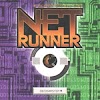
In
our first preview,
we looked at some of the reasons Fantasy Flight Games is excited by
the upcoming release ofAndroid:
Netrunner,
the reimagining of Richard Garfield’s classic 1990s card game of
megacorps, runners, and cybercrime. Today, we’re pleased to share
Mr. Garfield’s thoughts on seeing his game reimagined, the
introduction of identity cards for each of the game’s two sides,
changes to mechanics like trace attempts, and more!
How
do you feel about seeing Netrunner reimagined?
I
am delighted to see the Netrunner design alive
again. It has some mechanics in it I was very pleased with, and I was
sad they didn't get broader exposure. The Fantasy Flight Games
treatment has been respectful of the original and yet has layered on
some design additions and modifications that could bring a lot to the
table – something I have seen them do again and again.
 With
what part of the original game were you most pleased, and how do you
feel that Android: Netrunner has handled that
aspect?
With
what part of the original game were you most pleased, and how do you
feel that Android: Netrunner has handled that
aspect?
I
would say the best part of Netrunner was the space
for head games that would take place between the players. Sometimes,
in trading card games, it feels like the cards are playing you; the
card you draw each turn defines the game. In Netrunner,
you definitely play the cards, and you have enormous latitude
in how you play them. One measure of this is the question, “How
much would it affect things if I knew my opponents’ cards?” For a
game like Magic: The Gathering™ (and even more so
with many Euro-style games), for a lot of players and a lot of
situations, the answer is, “Not much.” You have to be very good
(or find yourself in an unusual situation) to bluff in Magic™.
In Netrunner, even the most casual player will very
quickly start bluffing and wishing they could see their opponent’s
cards.
This
part of the Android: Netrunner design seems
completely intact; it is exciting to see!
Another
part of the original I really liked was the sense of humor, something
that is fun to see in the new version as well.
What
were some of the challenges in designing the original Netrunner?
The
biggest challenge for the Netrunner design was that
the property really called for an asymmetrical design, or an
indirectly interactive one. It was a given that players were going to
be hackers. If players were going to play hackers, then they would be
competing directly with the organizations they were hacking
into. Those organizations could either be played by the game
system (creating indirect interaction between players) or by another
player (making the game very asymmetrical). I played around with
several designs where all the players were competing to run missions
against a world deck; this worked okay but lacked the bite that
direct head-to-head competition gives.
I
guess another challenge was simply the fact that when Netrunner was
designed trading card games were very young, and what was possible,
as well as their natural strengths and weaknesses, were not as
apparent. These days, a trading card game has ample examples of
successful designs and unsuccessful designs with brilliant
components from which they can draw inspiration and view as
cautionary tales.  We
were still flying in heavy fog back then.
We
were still flying in heavy fog back then.
 We
were still flying in heavy fog back then.
We
were still flying in heavy fog back then.
What
do you think about the game’s new identity cards for the
corporations and runners?
These
are fun. They give a starting point for strategy and deck-building,
and they are flavorful.
How
do you feel about the changes to some of the mechanics, like trace
attempts?
Almost
all are reasonable simplifications or elaborations on the original
mechanics. Some changes seem clearly good – like broadening the
runner's ability to participate in trace attempts, while others are
judgment calls. I am confident that care was taken not to change for
the sake of change.
Android:
Netrunner limits decks to three copies of a given card. What
kind of impact do you think this will have on the game?
It
will have little effect. The game was either released with or quickly
moved to a limit of four copies of a card. My standard in those days
was to attempt to design to allow unlimited numbers of cards, but
later to limit the players in post-publish metagame rules. Going from
four to three is not a big deal, and if anything, it will increase
the variety of possible designs.
Many
players suppose naively that more choices is more variety, but if you
are forced to play with fewer of your favorite cards, you have to add
more of your second-tier cards, and variation is introduced with this
choice.
Is
there any card or specific mechanic from the original game that
you’re excited to see get new life in Android: Netrunner?

I
like how the Corp has three inherently vulnerable points that can be
attacked by the Runner: the hand, the deck, and the discard pile. It
feels “hackery” to allow my opponent to rummage through these
three collections of cards unless I defend them, along with the more
traditionally vulnerable spots – the various assets put into play
during the course of the game.
Thank
you, Mr. Garfield!
As
fans of the original Netrunner, we’re excited to
reimagine its classic struggles between vast megacorps and subversive
runners, and we’re glad that Android: Netrunner has
earned the blessings of the game’s original designer.
We're
confident that you, too, will enjoy the exciting challenges of
cybercrime and futuristic enterprise in Android:
Netrunner.
It won’t be long before you have the chance to begin you
runs; Android:
Netrunner is
coming to Gen
Con Indy 2012!





0 Comments